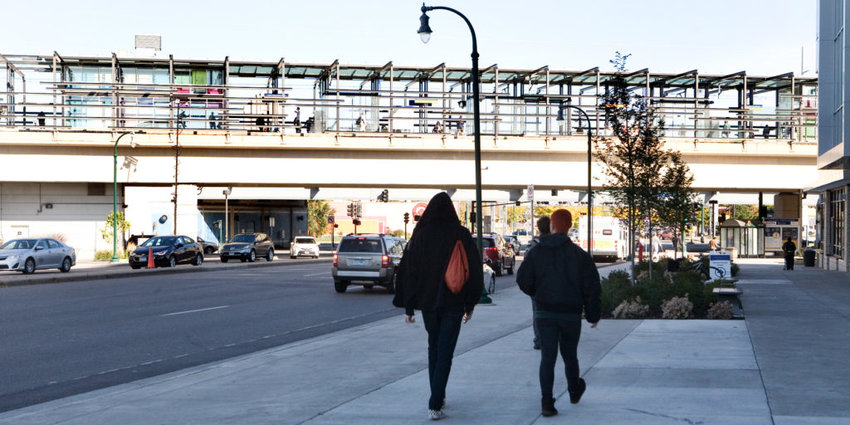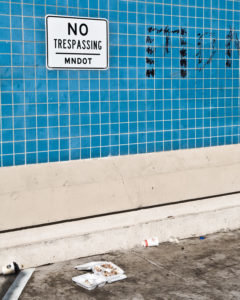 The intersection confounds motorists, pedestrians, and bikers alike. (Photo by Margie O’Loughlin) By MARGIE O’LOUGHLIN This summer saw a significant rise in activity underneath the overpass at Hiawatha Ave. and East Lake St. According to an update from Hennepin County Health and Human Services, a group of 5-25 people began occupying both sides of the road early in the summer. The group was predominantly Native American and was known to include both older drinkers and younger opioid users. Most of the members had cycled through detox and substance use services, as well as the criminal justice system. Some had housing and gathered under the bridge to socialize. Others had housing in the past but were unable to sustain it. Homelessness was one of many issues facing this group, but not necessarily the main one. The encampment, as it was called, has been abandoned since Tues., Oct. 3. On that night, 26-year-old Daquan Thompson was fatally stabbed on a corner near the encampment site. His assailant has been apprehended and charged with 2nd-degree murder in Hennepin County District Court.
The intersection confounds motorists, pedestrians, and bikers alike. (Photo by Margie O’Loughlin) By MARGIE O’LOUGHLIN This summer saw a significant rise in activity underneath the overpass at Hiawatha Ave. and East Lake St. According to an update from Hennepin County Health and Human Services, a group of 5-25 people began occupying both sides of the road early in the summer. The group was predominantly Native American and was known to include both older drinkers and younger opioid users. Most of the members had cycled through detox and substance use services, as well as the criminal justice system. Some had housing and gathered under the bridge to socialize. Others had housing in the past but were unable to sustain it. Homelessness was one of many issues facing this group, but not necessarily the main one. The encampment, as it was called, has been abandoned since Tues., Oct. 3. On that night, 26-year-old Daquan Thompson was fatally stabbed on a corner near the encampment site. His assailant has been apprehended and charged with 2nd-degree murder in Hennepin County District Court.  Following Thompson’s murder, the Minnesota Department of Transportation put up “No Trespassing” signs on both sides of the underpass, despite the fact that approximately 2,500 pedestrians and bicyclists pass through daily. Trespassers all, technically speaking (photo right by Margie O'Loughlin). The Hi-Lake Intersection brings a sad combination of physical infrastructure and social service problems to the neighborhood. Heidi Johnson McAllister, executive director of the Corcoran Neighborhood Association, said, “I don’t think you can fix one without fixing the other. We should be looking at addressing the physical space and the social issues together.” The infamous intersection was built in the 1990’s with the primary objective of moving motorized traffic. Some 34,000 cars and 350 buses travel through in eight different directions daily. The hoped-for outcome of improving the intersection will be to continue to move cars and buses, but to make it possible for bikers and walkers to travel safely too. Humanize Hi-Lake is a group made up of residents who’ve been pushing for change at the intersection for years. Following an in-depth study released in 2016, both Hennepin County and the City of Minneapolis are committed to making improvements there. McAllister said, “We are now entering into the phase of community engagement, with meetings beginning in November.” Contact Vanessa Haight, community development manager at the Corcoran Neighborhood Association, with questions about upcoming meetings of Humanize Hi-Lake. She can be reached at vanessa@corcoranneighborhood.org. Meeting dates will also be posted www.corcoranneighborhood.org and the Facebook pages of CNO and Humanize Hi Lake. Other community partners involved in the effort to bring about change include Our Streets and the North Star Chapter of the Sierra Club. Minneapolis City Council Representative Alondra Cano (Ward 9) and Hennepin County Commissioner Peter McLaughlin will also be involved.
Following Thompson’s murder, the Minnesota Department of Transportation put up “No Trespassing” signs on both sides of the underpass, despite the fact that approximately 2,500 pedestrians and bicyclists pass through daily. Trespassers all, technically speaking (photo right by Margie O'Loughlin). The Hi-Lake Intersection brings a sad combination of physical infrastructure and social service problems to the neighborhood. Heidi Johnson McAllister, executive director of the Corcoran Neighborhood Association, said, “I don’t think you can fix one without fixing the other. We should be looking at addressing the physical space and the social issues together.” The infamous intersection was built in the 1990’s with the primary objective of moving motorized traffic. Some 34,000 cars and 350 buses travel through in eight different directions daily. The hoped-for outcome of improving the intersection will be to continue to move cars and buses, but to make it possible for bikers and walkers to travel safely too. Humanize Hi-Lake is a group made up of residents who’ve been pushing for change at the intersection for years. Following an in-depth study released in 2016, both Hennepin County and the City of Minneapolis are committed to making improvements there. McAllister said, “We are now entering into the phase of community engagement, with meetings beginning in November.” Contact Vanessa Haight, community development manager at the Corcoran Neighborhood Association, with questions about upcoming meetings of Humanize Hi-Lake. She can be reached at vanessa@corcoranneighborhood.org. Meeting dates will also be posted www.corcoranneighborhood.org and the Facebook pages of CNO and Humanize Hi Lake. Other community partners involved in the effort to bring about change include Our Streets and the North Star Chapter of the Sierra Club. Minneapolis City Council Representative Alondra Cano (Ward 9) and Hennepin County Commissioner Peter McLaughlin will also be involved. *********************
What happens to groups of homeless people who congregate in visible places for a time, and then disappear? The encampment of mostly Native Americans at the Hi-Lake Intersection has disappeared, following a murder there on Oct. 3. The American Indian Development Council has been able to secure funding from the State of Minnesota and Hennepin County to open a housing facility for Native Americans with substance use issues. It will be a “low barrier” facility, meaning that residents can be admitted whether or not they are sober. The South Minneapolis facility will have up to 18 beds, be culturally specific to Native Americans, and will open in November. The opening of this facility is an important piece of the conversation around humanizing Hi-Lake: finding a place where people who need help can go. Heidi Johnson McAllister, Corcoran Neighborhood Association executive director, said, “Improvement of the Hi-Lake Intersection, to me, means that the underlying social issues are addressed as well as the physical problems of infrastructure.”
Comments
No comments on this item Please log in to comment by clicking here